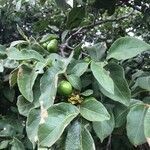Shrub or small tree 1.5–8 m. tall, very similar to the last species save for the indumentum; trunk smooth, grey or eventually rough and ridged; branches ridged, the young parts densely ferruginous, pubescent or velvety.. Leaf-blades elliptic, oblong-elliptic, ovate or sometimes almost round or lanceolate, 4–30 cm. long, 2.5–18 cm. wide, rounded, subacute or ± acute to shortly acuminate at the apex, rounded to cuneate or rarely ± subcordate at the base, often discolorous, deeply pubescent to usually densely softly velvety on both surfaces, the hairs often yellowish or ferruginous in dry state; petiole 0.3–1 cm. long, similarly hairy; stipules with base 2–4 mm. long and apical part 0.3–1.2 cm. long, hairy.. Inflorescences densely hairy, sometimes extensive and much branched but typically rather short, branches 1.5–3.5 cm. long, each 5–10-flowered; peduncles 6–8 mm. long; pedicels 1–2.5 mm. long, but those of the central flower of each dichasial element ± 3.5 mm. long.. Calyx-tube 0.75–1.2 mm. long; lobes obtusely triangular to narrowly oblong, 1–1.25(–2) mm. long.. Corolla green or yellow-green, typically densely spreading hairy outside but glabrous in some variants; tube 3–4.5 mm. long; lobes 3–4 mm. long with appendages up to 0.5 mm. long or practically obsolete.. Style 4.5–6 mm. long; stigmatic club yellow, 1 mm. long.. Fruit green, usually ripening to dull orange-brown or purplish, depressed subglobose, 1.5–4.7 cm. in diameter; pyrenes up to 1.3–2 cm. long, 0.6–1.3 cm. wide, 5–8 mm. thick.
Shrub or small tree, 2-7 m high; plants densely velvety. Leaves large, 40-300 x 25-180 mm, ± oblong-elliptic. Stipules connate at base, apex with linear appendage, villous within. Flowers in many-flowered, axillary, compound, dichasial cymes; bracteate. Calyx persistent, 5-lobed; tube saucer-shaped, lobes ovate. Corolla greenish yellow, hairy, 5-lobed; tube campanulate; lobes narrowly triangular, reflexed; villous in throat. Stamens 5, in corolla mouth; shortly exserted; filaments linear; anthers oblong. Ovary 5-locular, 1 pendulous ovule per locule; style terete, shortly exserted; stigma (pollen presenter) thickened, cylindric, furrowed, ± 5-lobed at apex. Fruit large, indehiscent, ± globose, with 5 pyrenes, crowned with circular scar from persistent calyx, edible.
A shrub or small deciduous tree. It grows to 3 or 4.5 m tall. It can be 7 m tall. It has a smooth grey trunk. The bark becomes rough with age. The branches are short and stout. They are soft and covered with red hair when young. The leaves are light green and leathery. The leaves are 5-30 cm long and 3.8-18 cm wide. They are often egg-shaped. The tips can be round or blunt and they are densely hairy. The veins are like nets. The flowers are greenish-white or yellow. They are small. They grow in clusters. The fruit are round and 3.8 cm across. They have a shallow crown on top and are covered with a light brown leathery skin. They have 3 seeds inside. Each seed is in a separate compartment.
Leaf blades 4–30×2.5–18 cm, elliptic to oblong-elliptic, ovate or sometimes almost round or lanceolate, rounded, subacute or ± acute to shortly acuminate at the apex, rounded to cuneate or rarely ± subcordate at the base, often discolorous, densely pubescent to usually densely softly velvety on both surfaces; the hairs often yellowish or ferruginous in dry state; lateral nerves in 6–8 main pairs; petiole 3–10 mm long, similarly hairy; stipules with base 2–4 mm long and apical part 3–20 mm long, hairy.
Inflorescences densely hairy, sometimes extensive and much branched but typically rather short; branches 1.5–3.5 cm long, each 5–10-flowered; peduncles 6–8 mm long; pedicels 1–2.5 mm long, but those of the central flower of each dichasial element c. 3.5 mm long.
Shrub or small tree 1.5–8 m tall, very similar to previous species save for the indumentum; trunk smooth, grey or eventually rough and ridged; branches often robust, ridged, pale or dark, the young parts densely ferruginous, pubescent or velvety.
Corolla rounded or apiculate in bud; green or yellow-green, typically densely spreading hairy outside but glabrous in some variants; tube 3–4.5 mm long; lobes 3–4 mm long with appendages up to 0.5 mm long, or practically obsolete.
Fruit green, usually ripening to dull orange-brown or purplish, 1.5–4.7 cm in diameter, depressed subglobose.
Calyx tube 0.75–1.2 mm long; lobes obtusely triangular to narrowly oblong, 1–1.25(2–2.5) mm long.
Pyrenes up to 13–20 × 6–13 × 5–8 mm.
Pollen presenter yellow, 1 mm long.
Style 4.5–6 mm long.


